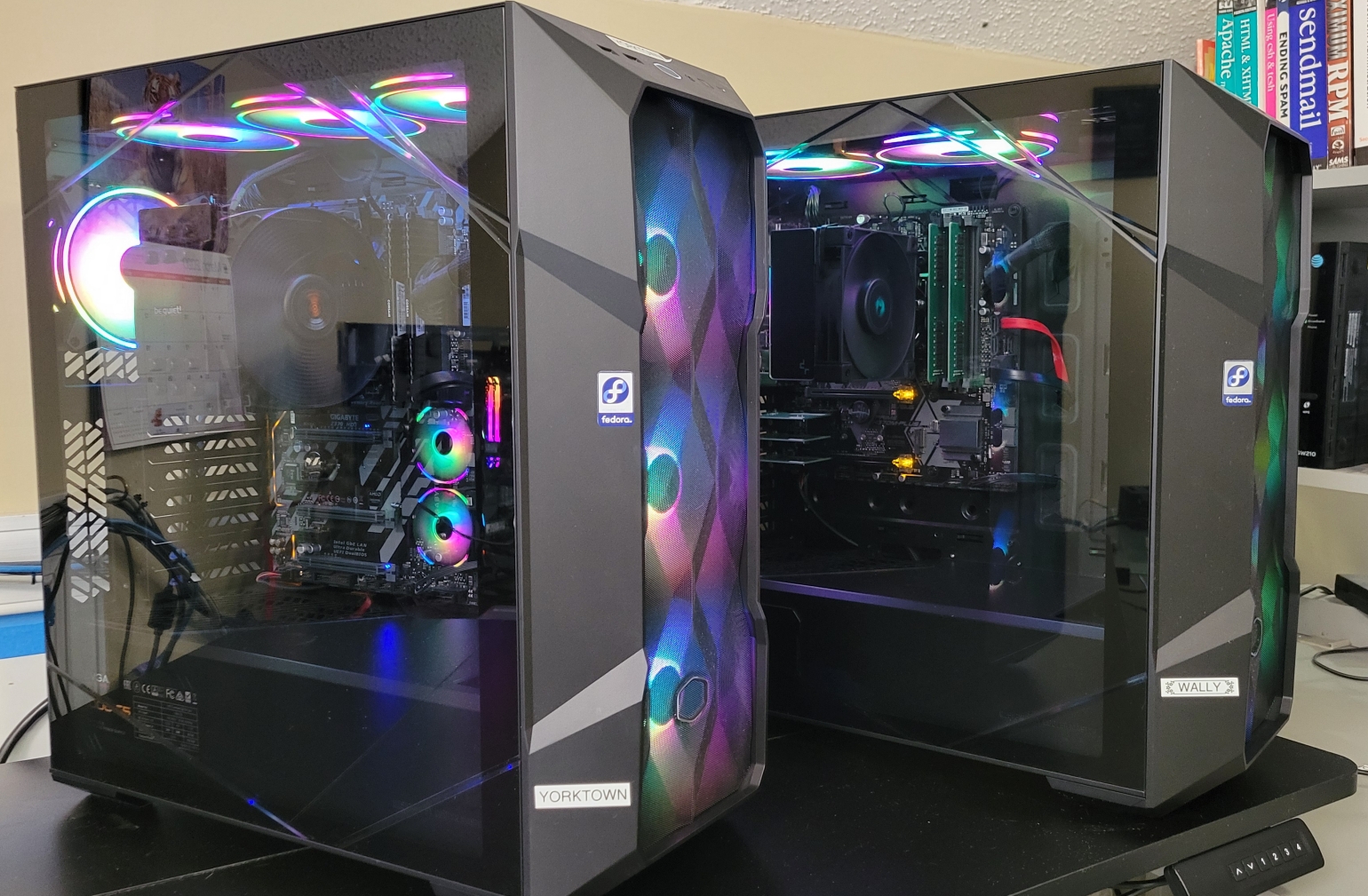
What our system maintenance this past weekend says about Linux
I’ve been thinking a lot about the system maintenance I performed on Saturday, February 22.
Prior to that day, I thought about what needed to be done, created a list of every task that needed to be performed, no matter how small. I even listed things like removing the side and front panels of the two systems that needed work. Things that might be simple and self-evident yet which might bork the entire maintenance if forgotten.
Of course, on the day of, I thought about each step of the plan as I worked it. I took a moment before each step to consider what could go wrong and how I’d recover if it did.
Reflections on Linux and upgrades
Since the maintenance was completed, I’ve continued to think about this particular maintenance plan. I’ve particularly been thinking about how it reflects on the value of Linux.
The server that hosts Both.org, yorktown, only needed cleaning and a new rear fan. But the host that is the firewall and router, named wally, that protects Both.org while providing access to the web site needed a new processor in addition to a good cleaning. Both of these hosts are shown in Figure 1 — after being cleaned and the upgrade performed. The firewall and router, wally, is on the right.

Figure 2 shows information about the motherboard, processor, and RAM of wally. It shows an Intel i5 processor with 6 cores but without hyper-threading, with a maximum speed of 4.1GHz. It also shows the motherboards BIOS release date of 04/03/2019, making it about 6 years old.
#----------------------------------------------------------------------
# System Serial No.: System Serial Number
# System UUID: 6b2f91fd-5043-a3d6-b7cf-04d9f51cd5c5
# Motherboard Mfr: ASUSTeK COMPUTER INC.
# Motherboard Model: PRIME H370M-PLUS
# Motherboard Serial: 190550974401411
# BIOS Release Date: 04/03/2019
#----------------------------------------------------------------------
# CPU Model: Intel(R) Core(TM) i5-9400 CPU @ 2.90GHz
# CPU Data: 1 Six Core package with 6 CPUs
# CPU Architecture: x86_64
# HyperThreading: No
# Max CPU MHz: 4100.0000
# Current CPU MHz: 3899.972
# Min CPU MHz: 800.0000
#----------------------------------------------------------------------
# RAM: 31.198 GB
# SWAP: 7.999 GB
#----------------------------------------------------------------------Figure 2. The firewall and router, wally, had an Intel i5 processor with 6 cores but without hyper-threading.
There was — and still is — nothing wrong with that processor. It’s been working fine and it kept up with the hundreds and even thousands of page views it routes daily between the Both.org server and our visitors while accruing nearly 24 years of runtime for World Community Grid. However, as our traffic continues to increase, I wanted to ensure that this, the least powerful of any of the systems in my network, could keep up with demand.
Also, truth be told, I do like working with hardware and performing upgrades just for the fun of it. So I spent $199US to purchase a new processor. It’s an i7 with 6 cores plus hyper-threading and a maximum 4.7GHz speed.
The upgrade was easy and after, wally’s specifications look like Figure 3.
#-----------------------------------------------------------------100-----
# System Serial No.: System Serial Number
# System UUID: 6b2f91fd-5043-a3d6-b7cf-04d9f51cd5c5
# Motherboard Mfr: ASUSTeK COMPUTER INC.
# Motherboard Model: PRIME H370M-PLUS
# Motherboard Serial: 190550974401411
# BIOS Release Date: 04/03/2019
#----------------------------------------------------------------------
# CPU Model: Intel(R) Core(TM) i7-8700K CPU @ 3.70GHz
# CPU Data: 1 Six Core package with 12 CPUs
# CPU Architecture: x86_64
# HyperThreading: Yes
# Max CPU MHz: 4700.0000
# Current CPU MHz: 4299.969
# Min CPU MHz: 800.0000
#----------------------------------------------------------------------
# RAM: 31.195 GB
# SWAP: 7.999 GB
#----------------------------------------------------------------------Figure 3. Wally’s specs after the upgrade to the new processor.
This is a significantly more powerful system, and all I did was upgrade the processor. The implications of this are staggering.
The implications
The first thing I think of is longevity. Longevity is an interesting word. I use it to emphasize that you can use your old computer longer and that by doing that you lengthen the useful life of the computer and decrease the number of computers you need to purchase in your lifetime. This both reduces demand for new computers and reduces the number of old computers being discarded.
Not only can older computers be repaired by replacing broken parts, they can even be upgraded. If the computer uses standard parts for the case, motherboard, and power supply, it can be upgraded continuously as newer and faster components become available. In some cases like the Both.org firewall/router, the processor can be upgraded without the need for a new motherboard. In other cases, I’ve upgraded a system with more and faster RAM without replacing the motherboard or processor.
In the very worst case, a system that uses standardized components can be upgraded with a new motherboard, processor, RAM, and power supply unit (PSU). In most circumstances, a decent PSU won’t need replaced even when the motherboard is replaced.
This still leaves the case itself, usually the PSU, and any storage devices such as HDDs, SSDs, and DVD storage devices that won’t need to be replaced in a major upgrade. This is still less expensive than purchasing a complete new computer system.
For an additional benefit, the older, perfectly good components removed from the system can be used to repair other old computers or to upgrade ones that are even older.
All modern Linux distributions can be used to keep even very old computers running. Linux imposes no dependencies on new, high-end hardware, or embedded chips designed to prevent you from upgrading the operating system on the computer you own.
Yes, I’m talking about Windows and it’s massive hardware requirements, along with the so-called “Trusted Platform Module (TPM).” If your computer doesn’t have the TPM, or lacks what it considers to be its “minimum requirements,”Windows will just tell you it’s not going to install on that computer.
Using Linux to extend the life of all those old but still working computers can significantly reduce the e-waste streams. It also saves money for their owners.
The caveats
Keeping old computers running depends upon being able to get parts when components fail.
Dell and HP both build good computers and repairing those computers is easy so long as replacement parts are available. But both of these vendors use proprietary forms for their power supplies, cases, and motherboards. So their parts are not interchangeable. You can still repair them, but you must obtain the proprietary parts to do so, usually at a premium cost.
I’ve encountered instances where the Dell and HP system hardware was explicitly designed to prevent it from being upgradable. For example, one system contained a single 4GB memory module. It could only accept a single module. The space that would normally be used to provide a second memory slot did not have a physical connector and was intentionally and permanently blocked so that a connector couldn’t be added. Of course that would have required some serious hardware hacking, but the BIOS was also designed to prevent the installation of additional memory.
The use of standard parts prevents this kind of monopolistic practice. The kind of standard parts that I used when I built wally. Don’t worry, you don’t need to build a computer like I did to get these benefits. A good local computer store will have computers with standard components available pre-built, or you can just order a computer to your own specifications and they’ll build it for you.
Thoughts
I can repair and upgrade all of my computers because I build them myself from standard parts. I can replace any of those standard parts. Such a computer is a “forever” computer. Replacing broken parts, or upgrading the system with newer more powerful components can keep it running for decades.
And Linux can power any computer, no matter how old, because it imposes no arbitrary restrictions on the hardware.
Resources
Articles here on Both.com
I have published several articles on this site about using Linux and new or reclaimed parts to restore older computers. Rather than reproduce all of that here, you can use the following links.
- As many as 400,000,000 Windows 10 PCs can’t be upgraded to Windows 11
- E-Waste – Where does it go?
- Why I Save Old Computer Parts
- Saving Old Computers – and the planet
- Saving Another Computer with Linux
- Your computer isn’t broken – it just needs Linux
External articles
Here are some additional articles published elsewhere.
- Mearian, Lucas, More than half of PCs can’t upgrade to Windows 11 — report, Computer World, 04/13/2022
- Tung, Liam, A surprising number of PCs can’t upgrade to Windows 11. Here’s why, ZDNet, 10/12/2022
- Vaughan-Nichols, Steven, 5 ways to save your Windows 10 PC in 2025 – and most are free, ZDNet, 06/04/2024